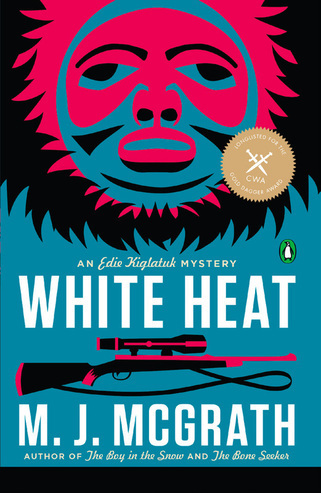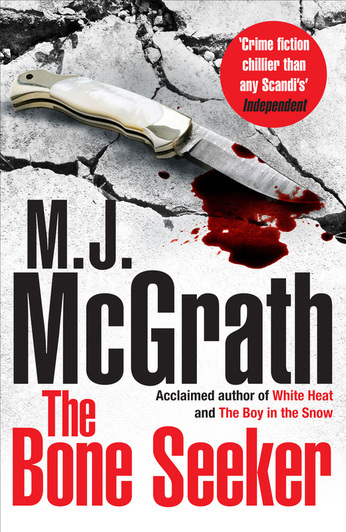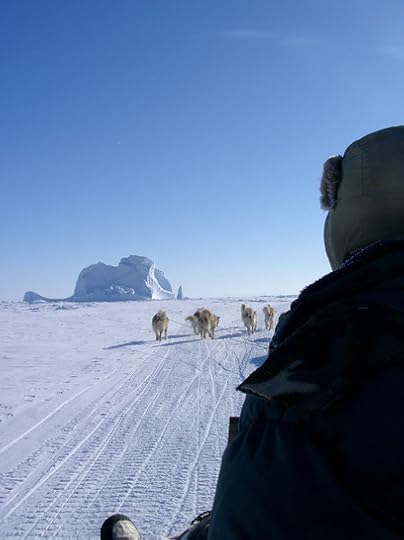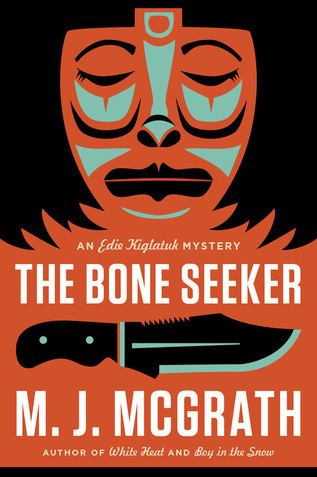M.J. McGrath's Blog
May 2, 2014
White Heat repackaged in USA
 Penguin USA have brought out the Edie Kiglatuk series in a smart new livery. Let me know what you think!
Penguin USA have brought out the Edie Kiglatuk series in a smart new livery. Let me know what you think!
Published on May 02, 2014 04:38
May 1, 2014
5 things you didn't know about crime in the the Arctic.
 1. The per capita homicide rate in Nunavut, Arctic Canada, is on a par with Mexico and South Africa
1. The per capita homicide rate in Nunavut, Arctic Canada, is on a par with Mexico and South Africa2. Violent crime in Nunavut is seven times higher than in southern Canada
3. In Alaska woman are four times more likely to become a victim of violent sex crime than in the lower 48 states of the USA
4. The violent crime rate across the Arctic is highest in summer
5. In Arctic Canada, which is 25 times the size of the UK, there are approximately 400 police and only 1 criminal intelligence officer
Published on May 01, 2014 12:50
Ten Great Arctic Books, some of which you'll have never heard of.
 1. Arctic Dreams by Barry Lopez – based on 15 trips to the region, this has become the classic of Arctic writing since it was first published in 2000.
1. Arctic Dreams by Barry Lopez – based on 15 trips to the region, this has become the classic of Arctic writing since it was first published in 2000.2. Ada Blackjack: A True Story of Survival in the Arctic by Jennifer Niven – the amazing account of the only survivor of noted explorer Vilhjalmur Stefansson’s ill-judged experiment to show that white men could survive in the Arctic
3. White Fang by Jack London – one of the first natures book written during the frontier years that puts itself firmly on the side of nature
4. People of the Deer by Farley Mowat – caused an international uproar when it was published in 1954 for highlighting the widespread starvation of inland Inuit in Arctic Canada.
5. Uqalurait: An Oral History of Nunuvut edited by John Bennett and Susan Rowley – a wonderful recounting of Arctic history and mythology by the Inuit themselves
6. The Arctic Voyages of Martin Frobisher: An Elizabethan Adventure by Robert McGhee – explorer literature tends to focus on the Victorian period but Frobisher got there four hundred years earlier. An astonishing story of resilience, grit and the exploring spirit
7. Farthest North by Fridtjof Nansen – the best of the Victorian era explorer accounts, first written in 1897.
8. Minik - Give Me My Father’s Body: The life of Minik the New York Eskimo by Kevin Spacey and Ken Harper. The poignant and shocking story of the Inuit brought to New York by Arctic explorer Robert Peary then abandoned. Was optioned for a film by Kevin Spacey
9. The Long Exile: A True Story of Inut Survival and Betrayal by Melanie McGrath. The shocking true story of the forced relocation of Inuit families to the High Arctic by the Canadian Government in the 1950s
10. Of Wolves and Men by Barry Lopez. No one captures the Arctic better than Lopez in this bittersweet recounting of the interaction between men and wolves.
Published on May 01, 2014 11:27
Prison letters
 Here’s a link to my guest blog on Murder is Everywhere about writing to an inmate.
Here’s a link to my guest blog on Murder is Everywhere about writing to an inmate.
Published on May 01, 2014 11:19
The Edie Kiglatuk Cookbook
 Readers of the Edie Kiglatuk series seem to be fascinated and a little grossed out by her (mostly) traditional diet. For those who’d like to try it at home, here are a few recipes…
Readers of the Edie Kiglatuk series seem to be fascinated and a little grossed out by her (mostly) traditional diet. For those who’d like to try it at home, here are a few recipes…Igunaq – walrus cheese
A classic. Stuff a walrus or other bladder with chopped raw walrus meat. Bury in the ground, leave over the course of a summer to ferment and break down. Dig up before the ground becomes too hard. Serve in slices.
Akutaq - Inuit Ice Cream
Originally a specialty of the Yupik people of coastal Alaska, Akutaq means ‘something mixed.’ Whip animal fat together with berries and add in some salmon or caribou meat. Suitable animal fats for Akutaq include reindeer or caribou, moose, walrus and seal. Berries can include cranberries, cloudberries, crowberries and blueberries. Serve cold or frozen.
A popular variant is Mouse Akutaq, using roots hoarded by mice in the burrows. It is traditional not to take all the roots but to leave a few for the mice to enjoy.
Pemmican
A Cree First Nations word. An invaluable high-calorie food, a favourite of Inuit, First Nations and Arctic explorers alike, as it is concentrated, easily stored and keeps well. Inuit and Arctic explorers often made a version of this to feed their sled dogs. Take 2 measures of lean meat, 2 scant measure of dried fruit and 1 measure of rendered fat. Dry the meat in a low oven or in the wind until crispy, then pound into powder. Grind up the fruit. To render the fat, melt until golden brown, strain out the solids, cool then repeat the procedure. When the rendered liquid fat has cooled a little, stir in the fruit and meat. The cooled pemmican will store well for a year or more.
Bannock – frybread
A Gaelic bowdlerization of the latin word panicium, meaning baked goods, or panis, meaning bread. Probably first brought to the Arctic by Scottish whalers, the ingredients for bannock were used as trade goods in exchange for furs and meat. This is a basic recipe, but bannock can also be made with dried fruits or meats.
Mix 3 large enamel mugs of white flour in a bowl with 1 teaspoon of baking powder, 1 teaspooon of of salt and 2 mugs of dried milk powder and 1 tablespoon of shortening. Mix in enough water to make a dough. No need to knead or leave to prove. Heat a little oil in a pan, spread out the dough evenly and fry, turning from time to time, until puffed and brown.
Goose baked in mud
This recipe is taken from the wonderful Yukon Cookbook by Leona Kananen. Edie Kiglatuk has a copy of this book which her author gave to her for Christmas one year. A few species of duck and goose visit Edie’s home on Ellesmere Island during the summer. Edie might make this with eider, snowgoose or even dovekies. Summer is also the best (and only) time for mud, the earth being frozen solid most of the rest of the year. Edie would also eat the bird’s intestines, head, legs, tongue and neck. Traditionally, the wings would be used as small brooms, the sinews as sewing thread and the beak carved into needles. The feathers would go to insulate cabins, make mattresses or decorate clothes. Nothing was ever wasted.
‘Clean goose and chop off legs and neck; leave feathers on. Salt inside, and tie goose around to hold in wings. Make a big ball of mud around goose, and lay this in a nest of hot coals; build a good-sized fire over it, and let it cook for 1 hour. To break open casing, insert a knife into it, and bang knife with a rock or log. The feathers will be pulled off with the clay.’
Published on May 01, 2014 09:39
First US reviews of The Bone Seeker
 Thrilled to share two great reviews of The Bone Seeker ahead of its publication in the US.
Thrilled to share two great reviews of The Bone Seeker ahead of its publication in the US. ‘Filled with cultural tensions, gorgeous Arctic scenery and pulsing suspense.’
Booklist starred review
‘McGrath effectively evokes the spare Arctic landscape and bring life to the people who have inhabited it for generations.’
Publishers Weekly
Published on May 01, 2014 09:05
December 2, 2012
December 02nd, 2012
 Click here to download free Edie Kiglatuk Christmas story (UK only - sorry US readers - I have been promised that this story will be available to you next Christmas!)
Click here to download free Edie Kiglatuk Christmas story (UK only - sorry US readers - I have been promised that this story will be available to you next Christmas!)
Published on December 02, 2012 02:21
November 12, 2012
Edie's world coming soon
 I'm expanding the site! Please check back soon for all sorts of amazing facts and figures on Edie Kigaltuk's world, plus maps and pictures. This pic is my dog team taken on sea ice of Jones Sound approx 1100km North of the Arctic Circle. It's March and about -40C
I'm expanding the site! Please check back soon for all sorts of amazing facts and figures on Edie Kigaltuk's world, plus maps and pictures. This pic is my dog team taken on sea ice of Jones Sound approx 1100km North of the Arctic Circle. It's March and about -40C
Published on November 12, 2012 01:17
November 2, 2012
Arctic homicide 10x national average
Crime has doubled in Nunavut, Canada's semi-autonomous Inuit territory in the last decade. Violent crime is 7 times higher than in southern Canada and there are 10 times the number of per capita homicides. If Nunavut were an independent state its per capita crime stats would put it on a par with Mexico or South Africa. The figures aren't much better for Alaska, where the sexual assault rate runs at twice the national US average. I will post on crime in Alaska at a later date. For now, though, those of you who'd like to explore the issues around the rise in crime in Arctic Canada might like to look at Patrick White's terrific article in The Globe and Mail here and top 10 comments on the piece here. I am indebted to White's article for much of the statistical information below.
The issue is extremely complex, as White's piece shows, and I can only give a very sketchy outline of it here. Cultural factors such as the breakdown of traditional gender roles, especially those of men, and other socially binding customs like food sharing play a part. Then there is the unwillingness of some Inuit to air their problems or to challenge their elders, the taboo against talking about the dead and an understandable suspicion of southern solutions, particularly if those are imposed. The availability of weapons is a major factor in the high suicide rate - young Inuit men are 40 times more likely to kill themselves than young men in the south. Alcohol too plays a part in individual cases, though studies have shown that it is not the most significant factor overall.
Of the socio-economic factors contributing to this rise in crime include overcrowding and other measures of social deprivation. Plus Arctic Canada, where 50% of the population is under 25, has a much more youthful population than in southern Canada.
Political factors include some level of political denial and 'political correctness' or sensitivity in the light of Nunavut's status as an Inuit-run territory. Nunavut is overdependent on state funding and is currently failing to meet its mandate to fill employment targets of to employ 85% Inuit. Currently, Inuit territorial administrative employees make up only about 50% of the whole, the remainder being filled mostly by southerners on short term contracts. Alcohol is regulated almost everywhere but there's no territory-wide policy as a result of which each community tends to do its own thing. Even where an individual can only order alcohol by permit, permitted quantities - up to 30 bottles of wine a month - can be tantamount to no regulation at all. Bootlegging is also relatively common and largely unpoliced.
The Arctic detachments of the RCMP are woefully underfunded with only 400 policemen and 1 intelligence officer serving an area 25 times the size of Britain. Relations between the RCMP and the Inuit have historically been strained and there are few indigenous police, judges or prosecutors, so law enforcement agencies can sometimes feel like an 'alien force'.
Lastly, it's worth saying that surveys show the climate does play a part, though not in the way you might think. Though people are most cooped up in the dark winter months, violent crime across the Arctic is actually higher under the midnight sun, possibly partly because sleep is very disrupted during this time.
The issue is extremely complex, as White's piece shows, and I can only give a very sketchy outline of it here. Cultural factors such as the breakdown of traditional gender roles, especially those of men, and other socially binding customs like food sharing play a part. Then there is the unwillingness of some Inuit to air their problems or to challenge their elders, the taboo against talking about the dead and an understandable suspicion of southern solutions, particularly if those are imposed. The availability of weapons is a major factor in the high suicide rate - young Inuit men are 40 times more likely to kill themselves than young men in the south. Alcohol too plays a part in individual cases, though studies have shown that it is not the most significant factor overall.
Of the socio-economic factors contributing to this rise in crime include overcrowding and other measures of social deprivation. Plus Arctic Canada, where 50% of the population is under 25, has a much more youthful population than in southern Canada.
Political factors include some level of political denial and 'political correctness' or sensitivity in the light of Nunavut's status as an Inuit-run territory. Nunavut is overdependent on state funding and is currently failing to meet its mandate to fill employment targets of to employ 85% Inuit. Currently, Inuit territorial administrative employees make up only about 50% of the whole, the remainder being filled mostly by southerners on short term contracts. Alcohol is regulated almost everywhere but there's no territory-wide policy as a result of which each community tends to do its own thing. Even where an individual can only order alcohol by permit, permitted quantities - up to 30 bottles of wine a month - can be tantamount to no regulation at all. Bootlegging is also relatively common and largely unpoliced.
The Arctic detachments of the RCMP are woefully underfunded with only 400 policemen and 1 intelligence officer serving an area 25 times the size of Britain. Relations between the RCMP and the Inuit have historically been strained and there are few indigenous police, judges or prosecutors, so law enforcement agencies can sometimes feel like an 'alien force'.
Lastly, it's worth saying that surveys show the climate does play a part, though not in the way you might think. Though people are most cooped up in the dark winter months, violent crime across the Arctic is actually higher under the midnight sun, possibly partly because sleep is very disrupted during this time.
Published on November 02, 2012 10:47
October 24, 2012
White Heat serialised on BBC R4 Xtra
Exciting news! White Heat is being serialised on BBC Radio 4 Extra Monday 12 Nov - Friday 16 Nov at 1.30pm and again at 8.30pm. Listen to the trail here:
Published on October 24, 2012 09:54
M.J. McGrath's Blog
- M.J. McGrath's profile
- 114 followers
M.J. McGrath isn't a Goodreads Author
(yet),
but they
do have a blog,
so here are some recent posts imported from
their feed.



